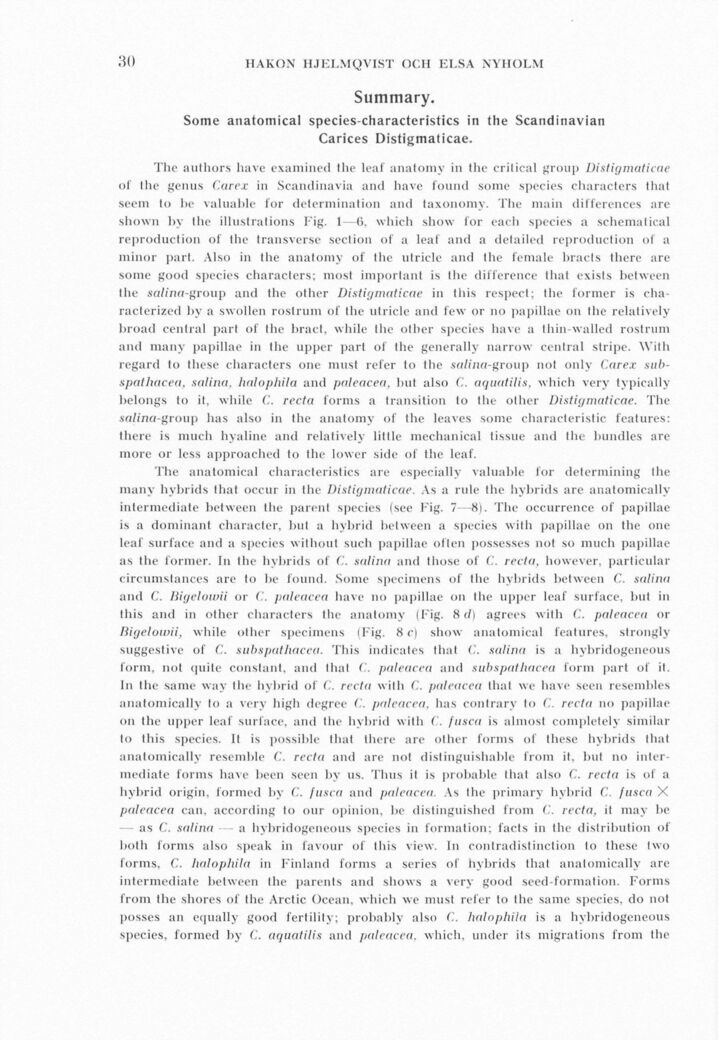
Full resolution (JPEG) - On this page / på denna sida - Sidor ...

<< prev. page << föreg. sida << >> nästa sida >> next page >>
Below is the raw OCR text
from the above scanned image.
Do you see an error? Proofread the page now!
Här nedan syns maskintolkade texten från faksimilbilden ovan.
Ser du något fel? Korrekturläs sidan nu!
This page has never been proofread. / Denna sida har aldrig korrekturlästs.
34 hakon hjelmqvist och elsa nyholm
Summary.
Some anatomical species-characteristics in the Scandinavian
Carices Distigmaticae.
The authors have examined the leaf anatomv in the critical group Distigmaticae
of the genus Carex in Scandinavia and have found some species characters t hat
seem to be valuable for determination and taxonomy. The main differences are
shown bv tlie illustrations Fig. 1—6, vvhich show for each species a schematical
reproduction of the Iransverse section of a leaf and a detailed reproduction of a
minor part. Also in the anatomy of the utricle and the female bracts there are
some good species characters; most important is the difference tliat exists between
the sa//n«-group and the other Distigmaticae in this respecl: the former is
clia-racterized by a swollen rostrum of the utricle and few or no papillae ön the relatively
broad central part of the bract, while the other species have a thin-walled rostrum
and many papillae in the upper part of the generally narrow central stripe. With
regard to lliese characters one must refer to the sa/ijia-group not only Carex
sub-spathacea, salina, halophila and paleacea. hut also C. aquatilis, which verv typically
belongs to il. while C. recta forms a transition to the other Distigmaticae. The
salina-group bas also in the anatomy of the leaves some characteristic features:
there is much hyaline and relatively little mechanical tissue and the bundles are
möre or less approached to the lower side of the leaf.
The anatomical characleristics are especially valuable for determining the
many hybrids that occur in the Distigmaticae. As a rule the hybrids are anatomicallv
intermediate between the parent species (see Fig. 7—8). The occurrence of papillae
is a dominant charader, bul a hybrid between a species with papillae ön the one
lea! surface and a species without such papillae often possesses not so much papillae
as the former. In the hybrids of C. salina and those of C. recta, however, particular
circumstances are to be found. Some specimens of the hybrids between C. salin a
and C. Bigelowii or (’.. paleacea have no papillae ön the upper leaf surface, bul in
this and in other characters the anatomy (Fig. 8 d) agrees w ith C. paleacea or
Bigelowii, while olher specimens (Fig. 8 c) show anatomical features, strongly
suggestive of C. subspathacea. This indicates that C. salina is a hybridogeneous
form, not quite constant, and that C. paleacea and subspathacea form part of it.
In the same way the hybrid of C. recta with C. paleacea that we have seen resembles
anatomicallv lo a very high degree C. paleacea. has contrary lo C. recta no papillae
ön the upper leaf surface, and the hybrid with C. fnsca is almost completely similar
to this species. It is possible that there are other forms of these hybrids that
anatomicallv resemble C. recta and are not distinguishable from it. but no
intermediate forms have been seen by us. Thus it is probable that also C. recta is of a
hybrid origin, formed by C. fusca and paleacea. As the primary hybrid C. fusca X
paleacea can, according to our opinion, be distinguished from C. recta, it may be
- as C. salina a hybridogeneous species in formation; facts in the distribution of
both forms also speak in favour of this view. In contradistinction lo these two
forms, C. halophila in Finland forms a series of hybrids |bat anatomicallv are
intermediate between the parents and shows a very good seed-formation. Forms
from the shores of the Arctic Ocean, which we must refer to the same species, do not
posses an equally good fertility; probably also C. halophila is a hybridogeneous
species, formed by C. aquatilis and paleacea. which, under ils migrations from the
<< prev. page << föreg. sida << >> nästa sida >> next page >>